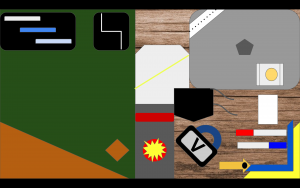When completing the “What’s In Your Bag” task the first time around, I defaulted to my most commonly used text communication, which was written in full, complete sentences that heavily relied upon adjectives and nouns, combined with photographs. This fell primarily into the linguistic design, as described by the New London Group (1996). My choice in how I completed the task reflected my most common textual experiences, with my occupation being in teaching and having lots of experience in an academic setting. With these factors in mind, I set out to transform my most commonly used elements by turning the photograph into an abstract piece of art and assigning sounds and verbs for each object
Reimagined What’s In Your Bag

Please see the above link for audio recordings
With the written description that was provided in the first iteration of this task, there was a clear lacking of audio design and that was a focus of the semiotic reimagining. With the assigning of sounds to each object, there is a transformation of the linguistic language that is typically correlated with the object to a sound that can form that association instead. The audience is then free to come up with their own interpretation, allowing for the integration of pre-existing knowledge and personal cultural interpretations that may have been limited previously. With the reading of the words, there is another layer of audio design, as the New London Group acknowledges that spoken language is as much part of the audio design as it is part of the linguistic design (pg. 29).
Another aspect that I wanted to transform was the visual representation. In the first version, the available design was a photo, whereas I wanted to mix the available designs, with the first being audio, to a visual design that focused more on perspective and colours. While I kept many of the colours consistent, I chose to rearrange some object representations and tried to communicate personal significance through which representations I placed in the foreground and the sizing of each representation. I found that a strength of the redesign process was allowing the audience to bring in more of their personal interpretation and potentially open up discussions about the meaning and personal identity.
A challenge that I had in the redesign of this task was redesigning the task into something that was still meaningful for me. Since the first iteration was my preferred method of communication, I felt confident putting that text out there since I felt my meaning would be clear and refined. With this new redesign, I feel that my intended meaning may be a bit diluted and that limited my confidence in creating this version. However, in doing so, the redesign process may make my initial work easier for someone else to understand and acknowledge the multiplicity of design.
References
The New London Group. (1996). A pedagogy of multiliteracies: Designing social futures. Harvard Educational Review 66(1), 60-92.